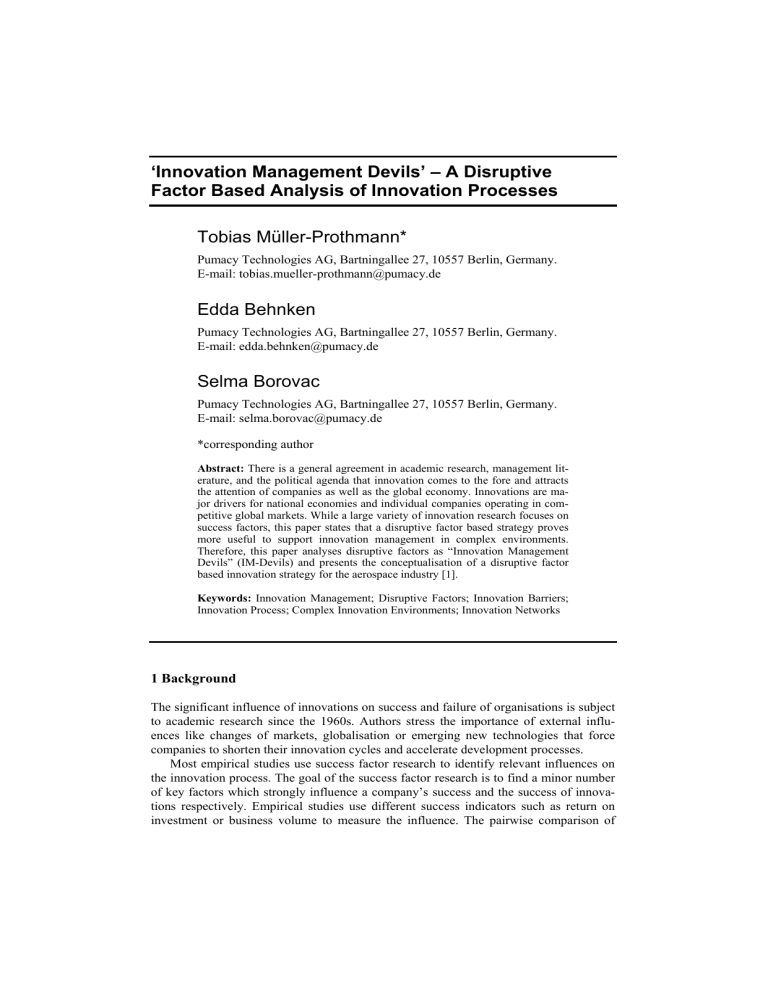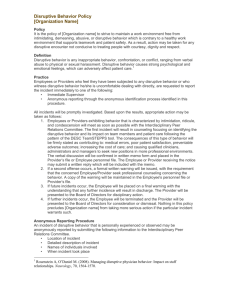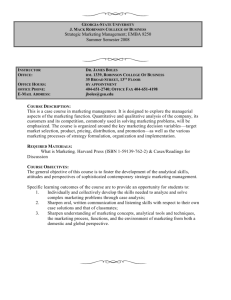Innovation Management Devils

‘Innovation Management Devils’ – A Disruptive
Factor Based Analysis of Innovation Processes
Tobias Müller-Prothmann*
Pumacy Technologies AG, Bartningallee 27, 10557 Berlin, Germany.
E-mail: tobias.mueller-prothmann@pumacy.de
Edda Behnken
Pumacy Technologies AG, Bartningallee 27, 10557 Berlin, Germany.
E-mail: edda.behnken@pumacy.de
Selma Borovac
Pumacy Technologies AG, Bartningallee 27, 10557 Berlin, Germany.
E-mail: selma.borovac@pumacy.de
*corresponding author
Abstract: There is a general agreement in academic research, management literature, and the political agenda that innovation comes to the fore and attracts the attention of companies as well as the global economy. Innovations are major drivers for national economies and individual companies operating in competitive global markets. While a large variety of innovation research focuses on success factors, this paper states that a disruptive factor based strategy proves more useful to support innovation management in complex environments.
Therefore, this paper analyses disruptive factors as “Innovation Management
Devils” (IM-Devils) and presents the conceptualisation of a disruptive factor based innovation strategy for the aerospace industry [1].
Keywords: Innovation Management; Disruptive Factors; Innovation Barriers;
Innovation Process; Complex Innovation Environments; Innovation Networks
1 Background
The significant influence of innovations on success and failure of organisations is subject to academic research since the 1960s. Authors stress the importance of external influences like changes of markets, globalisation or emerging new technologies that force companies to shorten their innovation cycles and accelerate development processes.
Most empirical studies use success factor research to identify relevant influences on the innovation process. The goal of the success factor research is to find a minor number of key factors which strongly influence a company’s success and the success of innovations respectively. Empirical studies use different success indicators such as return on investment or business volume to measure the influence. The pairwise comparison of
successful and unsuccessful companies leads to the identification of internal and external factors with positive effects on success indicators. These factors are called success factors
[3]. Empirical studies, however, have been often criticised.
First of all, the critiques of success factor research focus on the methodical level [2]:
•
Heterogeneous methods of investigation:
Inconsistent methods of collecting and analysing data induce to less comparability.
•
Limited scope:
Focusing on success factors as the subject of investigation results in a limited scope; however, success factors may be influenced by other/additional variables that have not been taken into consideration.
•
Missing test of stability over time:
The impact of success factors alters in time due to constant changes in the environment of a company.
•
Key informant bias:
Respondents should give information about complex issues, but this information succumbs a conscious and unconscious subjective contortion.
•
Simultaneity:
The success of accomplished measures cannot be evaluated separately from the initial situation.
Apart from a critical discussion of empirical studies in the academic literature, they are of minor significance for practical application. Empirical studies and practical experiences show that increased planning performance and efficient process design do not contribute to sustainable innovation success. Due to the fact that a company’s success is influenced by many interdependent internal and external variables, there is considerable doubt about the assumption that only isolated variables can be evaluated [3]. As recent research suggests, linear models do not meet the requirements of innovation processes caused by complexity [4].
With regard to practical applications of conventional innovation management methods, experiences show that there is no “one size fits all” strategy. Specific influences and conditions, organisational cultures and environments demand for individual strategies as well as the specific subject of innovation does not allow for a single successful procedure. Current trends as Open Innovation and the continuously increasing demand for collaboration lead to additional factors of uncertainty. Therefore, we may conclude that common innovation management models are not flexible enough and do not provide sufficient support for dynamic (re-) actions to meet the real conditions of complex processes and environments.
2 Approach
This paper presents first results of a study of disruptive factors in innovation management processes, so-called “Innovation Management Devils” (IM-Devils). They provide the background for the future development of an analytical tool, the “Innovation Profiler”, to evaluate innovation processes. The strategy conceptualisation relates to an extensive
study of innovation and complexity research literature. An explorative expert survey additionally stresses expert insights and practical demands.
Based on state-of-the-art research and taking into account known shortcomings of existing innovation management models, the conceptualisation of a disruptive factor based innovation strategy considers results from complexity research. The disruptive factor based strategy proves useful to analyse the innovation processes of an organisation and its environments. It will be explored with a focus on the aerospace industry that shows an extremely high level of industrialisation and high technology orientation.
A Disruptive Factor Based Innovation Strategy
Innovations imply a substantial change of structures, processes, and functions to organisations and are major drivers of current developments and future success. However, expected success may be reduced through disruptive factors. A disruptive factor is defined as a barrier to the innovation process, which inhibits, delays or converts an innovation
[5]. Thus, disruptive factors can also be called “barriers to innovation” [10] or just “barriers”. In contrast to other approaches, a barrier may also have a positive influence on the innovation, e.g., in terms of filtering inadequate or unusable ideas. A huge variety of kinds of barriers and possible classifications can be found in the literature as presented in the table below. Here, barriers are mainly explored within a limited focus.
Table 1: Studies of barriers to innovation and their classifications [6] author field of research / restrictions
Corsten (1989) typical weaknesses in innovation processes, a literature survey von Braun
(1994)
Christensen
(1997)
Christiansen
(2000)
Klein (2002) factors influencing R&D impact of technologies developed by competitors internal influences on innovation activities and success internal barriers affecting on the level of “individual” or “organisation”
(classification of) barriers
• organisational
• personal
• environmental
• planning
• not influenceable marginal conditions
• influenceable marginal conditions
• control values
• effect variables
• sustaining technologies
• disruptive technologies
• corporate-related
• project-related
• ability barriers
• knowledge barriers
• functional barriers
• intentional barriers
• affective barriers
author
Strina (2003)
Corsten et al.
(2006)
IBM (2006) field of research / restrictions types of problems in internal innovation processes innovation barriers caused by the corporate culture survey of some 765 CEOs
(classification of) barriers
• overvaluation of own requests and needs towards the one of the customer
• inadequately analysing of competitors
• unsystematic proceeding
• not using strategic alliances
• products in spite of systemic solutions
• strict focusing division targets
• dominant hierarchy
• selective and restrictive information politics
• internal
• external
To understand the multiple causes and effects of innovation barriers, it is important to note their multidimensional character. In order to improve the innovation capability, we have to systematically take into account the different fields of innovation activities, to involve the innovation environment, and to develop a holistic view. Figure 1 presents a possible structure of innovation barriers.
Figure 1: Barriers to innovation barriers to innovation internal external personrelated organisational technical interorganisational marketrelated others
Our conceptualisation of a disruptive factor based innovation strategy includes both specific internal and external complexities during the different stages of the innovation process. In opposite to linear models, a recursive structure ensures collective learning processes [4]. Focusing on the multidimensional character and individual conditions of an organisation, the evaluation of innovation barriers leads to basic approaches for practical solutions and preventive measures. Increasing complexity of new technologies forces companies to form interdisciplinary and inter-organisational teams or to institutionalise innovation networks. Efficient network strategies require managing processes by negotiations and coordination of activities and interfaces. Furthermore, the absorption and integration of external knowledge has to be ensured [7]. The disruptive factor based strategy presented in this paper takes into account the upcoming importance of networked innovations and their specific requirements.
As presented in Figure 1, barriers of innovation can be subdivided into internal and external barriers. The most considerable barriers are the internal ones, whereby the per-
son-related and organisational barriers come to the fore of all considerations [8]. These barriers will be presented in the following section. Technical barriers will not be described, because their characteristics and developments strongly depend on innovative tasks and contain, e.g., technological immaturity of processes or products as well as a missing technical environment of available resources and/or suppliers. Therefore, solutions of technical barriers can be rather influenced by technology and procurement management than by innovation management approaches.
Person-related Barriers
Resistance against change is not a common human reaction. It mostly results from fears of uncertainty. This reaction depends on the individual involvement, personality structure and experiences. Resistance against innovations have not always to be understood as negative reactions. They may also be warning signals caused by possible deficits of information or missing inclusion. A slow-down of the project process could be used to evaluate the planning and to unfold a protection and/or a filter function. Moreover, these resistances refer to a conscious altercation with the change. Generally, resistance to innovation shows different characteristics:
• personality characteristics of employees, who are against innovations,
• organisational culture,
• point of time of innovation (urgency of a solution for a known problem),
• behaviour of other participants,
• power and influence of the group and
• external environmental impact [9].
Person-related barriers refer to inter-personal resistances [12]. On the individual level, they may be distinguished as barriers of ability and motivational barriers (Figure 2).
Figure 2: Person-related barriers person-related barriers ability motivation knowledge
• missing knowledge
• misinterpretation due to available knowledge
• disability to acquire knowledge functional
• traditional roles
• competence
• communication intentional
• satisfaction with status quo
• prevention of aggravation
• lack of willingness to learn affective
• uncertainty/fear
• values and attitudes
• prejudice
• ambition for adjustment
Source: Klein, H. (2002) ‘Internal Corporate Venturing’ [10]
Knowledge barriers describe attributes of “to be not able to”. To be innovative, it is necessary for organisations to learn. Due to old habits and patterns of organisational members, the ability to learn is a difficult process. New habits and patterns are compared with the existing. New patterns lack of experience. Therefore, people try to abide by the old patterns and habits [10].
Functional barriers result from restrictions through organisational instructions, rules, and regulations (“to be not allowed to”). Apart from the formal roles (competence barrier), the specific behavioural role within an organisation and the social relations to its other members affect the acceptance of innovations. The innovator can provoke resistances within the company due to his or her own understanding of these behavioural roles. A negative tenor concerning all members who are involved in innovation processes can lead to selective perception. In this case, the innovator will respond less to objections or improvement suggestions of the other members. This process is frequently strengthened by the self-dynamics of the administration. Beyond the described competence barriers, there can also appear communication and language barriers. An example for these barriers is the interface between technical innovator and budget decisions.
Motivational barriers possess an intentional and an affective component and can be described as “to be not willing to“. The source of intentional barriers is the incompatibility of the change caused by personal objectives. Affective barriers result from a strongly subjective, emotional resistance. Personal values and settings may contradict the content of innovation. Existing prejudices, for instance, are expressed by refusal of foreign solutions. This syndrome is called “not invented the here” (NIH). The NIH syndrome represents a negatively valued, invalid and generalised attitude of individuals and/or groups toward externally developed technologies and may cause sub-optimal use of external solutions [11]. Dynamic processes within groups lead to the formation of majority opinions. Minorities follow these opinions in order to not to lose their status within the group.
External group pressure additionally reinforces this behaviour [12].
Organisational Barriers
The internal structure of a company, expressed by the organisational chart, is designed to achieve its primary goal. For classical industries, production of goods is their main task.
This shape of the structure contains the formation of organisational units (e.g., divisions, departments and positions) and the allocation of tasks as well as instruction and information relations. The described relations lead to a creation of hierarchical levels, similar to the structure of pyramids. Organisational structures aligned at the routine processes have the tendency to solidify themselves. Firm hierarchical relations and functional structure in divisions and positions foster the formation of operational islands (Figure 3).
Different functions, languages, preferences, and goals as well as asymmetrically distributed information are channelled within these horizontal and vertical organizational units. Internal interfaces between departments frequently represent an important barrier to innovation. In some cases, even oppositional groups and alliances may develop. These alliances do not only mutually block each other, but also hinder innovation paths [13].
This kind of group-building is an example of mutual influence of structure and culture within a company [14]. Organisational culture is a dynamic process that is influenced by internal and external factors. This process of change is taking place slowly and mainly through small steps. Measures to influence the change processes in companies should be planned in the long term. Apart from the global organisational culture, subcultures exist
within organisational units as well as on the different hierarchical levels described above.
Their partly opposite premises often cause conflicts. The emergence of oppositional groups is strengthened by opposite subcultures.
Figure 3: Mutual intensification of organisational barriers to innovation
+ = management barriers functional barriers operative islands
Source: Following Oetzel, A. (1997) ‘Wachstum durch Innovation‘ [ 15 ]
However, organisational culture itself may also inhibit innovations. Developments that are not legitimised by the existing culture can hardly be interspersed. This particularly concerns radical innovations [16]. Inhibition of innovation cultures can be characterised as:
• strong orientation toward departmental or divisional goals,
• dominance of hierarchy (no dissemination of decision power, adherence of formal procedures),
• selective and restrictive information policies [17].
Group culture is considerably affected by the behaviour of group members. In companies, this specially applies to the behaviour of management. During founding, entrepreneurs create a culture that is developed by its steering interferences as well as internal and external influences. Therefore, leadership personalities and organisational culture have a strong interdependent relationship.
An example for the rigid organisational structure and/or culture is the establishment of so called “boot-legging” projects. “Bootlegging is research in which motivated individuals secretly organise the innovation process. It usually is a bottom-up, nonprogrammed activity, without the official authorisation of the responsible management, but for the benefit of the company. It is not in the department’s action plan nor are there any formal resources allocated towards it” [18].
External Barriers
Companies are not composed as closed systems as they have various mutual relationships to their environment. Increasing complexity of innovations requires new forms of division of labour. Extensive and heterogeneous knowledge components can hardly be made by single companies, thus, cooperations become inevitable [19]. Possible forms of cooperation are: subsidiary companies, joint ventures, long-term general agreements and short and medium-term contractual regulations. Contrary to internal processes, these forms are not based on the dedication of instruments of power. Instead, the coordination mecha-
nisms at markets occur over negotiations and confidence between cooperation partners
[20]. Innovation networks are considered as particularly successful methods of cooperation. Their flexible and dynamic organisational structure enables a fast adjustment on changing market conditions. Control of networks is considerably dependent on hierarchical relationships of participants. Interfaces between companies are sources of different barriers:
•
Dominant companies basically have different instruments of power for the penetration of their interests; however, their use is regarded as critical [21].
•
Cooperation in networks is not inevitable formally regulated; positive effects of the network can be overlaid by inefficient transaction processes [22].
•
Opposite cultures, routines and established operational procedures limit the way of thinking and make cooperation more difficult [23].
•
Cooperation partners possess different paces and time horizons [20]; different priorities are important disruptive factors in innovation networks.
•
Frequently, there exists the fear of one-sided discharge of know-how; absence of confidence in the relationship of cooperation partners leads to restrictive flow of information [24].
•
Stereotyped classifications of “internal“ and “external“ capacities and missing inclusion of employees into externally accomplished developments lead to intensified occurrence of the NIH syndrome [25].
Apart from the influence of cooperation partners, companies are subject to further influences of the market. These influences can also be a cause for barriers to innovations.
Some companies establish market entrance barriers to achieve advantages of their pioneer strategy. On the one hand, these barriers exist in form of legal protection from imitation
(patents) and, on the other hand, in the utilization of knowledge and time projection (e.g., experience curve advantages, product differentiation, entrance to sales and sources of raw material). The effect of these market entrance barriers depends on the individual characteristics of the company that wants to enter the market.
Finally, external barriers to innovation include international, national and social restrictions. They may only indirectly be affected from a long-term perspective (e.g., by public relations). For short and medium-termed innovation strategies these barriers illustrate a limitation of their action framework.
3 Conceptualisation
Disruptive Factor Based Analysis
A disruptive factor based analysis aims at the identification of barriers within the innovation process for the development of suitable approaches and strategies to adequately deal with them. The actual situation is expressed as a noticed, undesirable deviation from a target condition within the context of innovation processes. Disruptive factors may be noticed by any involved or concerned person during the whole innovation process.
For a disruptive factor based analysis of innovation processes, the actual situation is analysed with regard to the identification of barriers. Then, these barriers are described according to the different dimensions. Furthermore, a disruptive factor based analysis detects interdependences between different barriers and their influence on the success of an innovation. The complex evaluation of disruptive factors and the analysis of their interrelations allow for the development of a holistic and individually customised solution, taking into account organisation specific characteristics. The process of a disruptive factor based analysis of innovation processes is divided into three steps (Figure 4):
1.
identification of disruptive factors,
2.
systematic description of disruptive factors, and
3.
evaluation of disruptive factors.
Figure 4: Analytical process actual situation identification description evaluation IM Devils analysis of disruptive factors
Identification of Disruptive Factors
Starting point for the identification of disruptive factors is the specific innovation process of an organisation, i.e. the actual situation (as-is status). Input about the actual situation is not structured, i.e. input is a (more or less complete) collection of information about specific innovation processes and its barriers. Due to this assumption, every single disruptive factor will be identified in the first step. This aims at the extraction of single, clearly defined disruptive factors from a larger, complex or even diffuse set of disturbances. For the process of extraction of clearly defined disruptive factors from the actual situation it is important to focus on objective information and to know how to adequately deal with presumptions. Identified disruptive factors are then systematically described in a next step.
Systematic Description of Disruptive Factors
In a second step, the analysis aims at a systematic description of the disruptive factors identified in step one. Then, they are ready for evaluation in a final step. Systematic description of disruptive factors includes (Figure 5):
1.
classification of disruptive factors identified in step one,
2.
description of interaction/inter-relation between disruptive factors,
3.
aggregation of disruptive factors according to different dimensions (see below),
4.
visualisation of disruptive factors.
Figure 5: Systematic description of disruptive factors classification of disruptive factors description of interaction between disruptive factors aggregation of disruptive factors visualisation of disruptive factors description of disruptive factors
Starting point for a classification of disruptive factors is the analysis of their causal structure. While the total effect of disturbances remains on a superior meta-level, we need to assign every individual disruptive factor to its cause. Background and functionality of each disruptive factor are described according to the different dimensions outlined below.
Then, the analysis focuses on the description of interactions and inter-relations between the various disruptive factors. Their interaction is understood as the interdependence between disruptive factors and their influence on each other with regard to the characteristic, dimension-related values. For further evaluation, systematically described disruptive factors are aggregated according to the dimensions outlined below and their interrelationships are visualised.
Dimensions of Disruptive Factors
To support a disruptive factor based analysis of innovation processes, we need a defined structure for their description. These structural dimensions provide the basis for a systematic analysis of disruptive factors and their impact on the overall innovation process
(Figure 6).
For a systematic analysis, disruptive factors of innovation processes can be described according to three dimensions:
• causes,
• effects, and
• phase-specific characteristics.
These three dimensions establish a clear method to analyse disruptive factors of innovation processes:
•
Causes: The formation of barriers to innovation takes place on the basis of the internal and external causes of a disruptive factor (cf. Figure 1). For each disruptive factor, a barrier to innovation may be ascribed to a specific cause. Internal causes are of
personal, organisational or technical nature, whereas external causes can be distinguished with regard to their intra-organisational, market-related or other (social or national restrictions) character.
•
Effects: According to the definition of effects, an effect of barriers to innovation is composed on
− prevention,
− delay or
− deformation of the innovation.
This list presents a specific ranking of effects. Here, prevention is the most radical form of an effect of barriers to innovation. Members of an organisation who are opponents to innovations may try to prevent the innovation development at all. Reasons for the objection to innovations may be of technological, marketing, financial, economical or ecological nature. Opponents particularly focus on the risks of the innovation and want to keep the current state. If the prevention strategy is not possible or not successful, opponents may try to delay the innovation process. In case that even the active or passive delay of the innovation process is not possible, there remains the possibility of deformation of the innovation to prevent radical changes.
•
Phase-specific characteristics: Occurrence and shape of barriers to innovation largely depend on the specific phase of the innovation process. Barriers frequently arise during the concrete realisation of the innovation process [10]. Particularly during early phases of innovation processes, there is often a lack of support from the top management (prior to the decision-making on project realisation). This negatively affects subsequent phases of innovation outcomes [26].
Figure 6: Dimensions of barriers actual situation disruptive factor disruptive factor disruptive factor
Evaluation of Disruptive Factors
The disruptive factors described in detail and visualised with regard to their interrelationships in the previous step provide the basis for further evaluation. Based on their priority for the overall innovation process, a ranking of the disruptive factors is generated. Priority is dependent on the innovation system and the strategic innovation goal of
the specific organisation. Besides, we should take into account that not every single disruptive factor can be objectively evaluated. For instance, evaluation of the positive or negative effects of a company’s success results from subjective input of the involved participants and their documents. Nevertheless, it is important to evaluate all disruptive factors to find a suitable approach for their elimination or, at least, their reduction.
4 Conclusion
Output of the evaluation is a systematic analysis of disruptive factors of the innovation process. These results are called “Innovation Management Devils” (IM-Devils). IM-
Devils are used as input for further development of solutions and preventive measures to achieve a high reliable innovation management strategy for complex environments.
As this paper outlines, individual barriers to innovation of a company are subject to dynamic internal and external processes of change. Therefore, identification and systematic analysis of disruptive factors on a regular basis are strongly recommended to constantly verify innovation management activities. A recursive process ensures inclusion of feedback loops and measures to achieve new developments. Recurrent identification of disruptive factors provides solutions for and success of innovations. Additionally, a longlasting implementation guarantees further development of the analytical process itself.
Effectiveness and efficiency can be increased by a learning process and the possibility of observing long-term influences through a growing data base of disruptive factors of innovation processes.
References and Notes
1 Results presented in this paper are part of the INNOPLEX project at Pumacy Technologies
AG, co-funded by the European Union (European Regional Development Fund in Berlin,
Germany).
2 Nicolai, A. and Kieser, A. (2002) ‚Trotz eklatanter Erfolglosigkeit: Die Erfolgsfaktorenforschung weiter auf Erfolgskurs‘, Die Betriebswirtschaft , Vol. 62. Nr. 6, pp. 579-596. Haenecke,
H. (2002) ‘Methodenorientierte Systematisierung der Kritik an der Erfolgsfaktorenforschung’,
Zeitschrift für Betriebswirtschaft , Vol. 72, Nr. 2, pp. 165-183. Woywode, M. (2004) ’Wege aus der Erfolglosigkeit der Erfolgsfaktorenforschung’, in KfW Bankengruppe (Ed) Was erfolgreiche Unternehmen ausmacht , Heidelberg: Physika Verlag, pp. 15-48.
3 Haenecke, H. (2002) ‘Methodenorientierte Systematisierung der Kritik an der Erfolgsfaktorenforschung’, Zeitschrift für Betriebswirtschaft , Vol. 72, Nr. 2, pp. 165-183.
4 Kline, S. and Rosenberg, N. (1986) ‘An Overview of Innovation’, in Landau, R. and
Rosenberg, N. (Eds.) The Positive Sum Strategy: Harnessing Technology for Economic
Growth , Washington, DC: National Academy Press, pp. 275–305.
5 Mirow, C., Hölzle, K., Gemünden, H. (2007) ’Systematisierung, Erklärungsbeiträge und Effekte von Innovationsbarrieren‘, Journal für Betriebswirtschaft , Vol. 57, Nr. 2, pp. 101-134.
6 Corsten, H. (1989) ‘Überlegungen zu einem Innovationsmanagement - organisationale und personale Aspekte’, in Corsten, H. (Ed.) Die Gestaltung von Innovationsprozessen: Hindernisse und Erfolgsfaktoren im Organisations-, Finanz- und Informationsbereich , Berlin: Erich
Schmidt Verlag, pp. 1-56. von Braun, C. (1994) Der Innovationskrieg: Ziele und Grenzen der industriellen Forschung und Entwicklung , München, Wien: Hanser. Christensen, C. (1997)
The innovator's dilemma: when new technologies cause great firms to fail , Boston, Massachusetts: Harvard Business School Press. Christiansen, J. (2000) Competitive Innovation Management: Techniques to improve innovation performance , Houndmills et al.: Macmillan Press.
Klein, H. (2002) Internal Corporate Venturing: Die Überwindung von Innovationsbarrieren in DAX 100-Unternehmen , Dissertation, Wiesbaden: DUV. Strina, G. (2003) ‘Stand der Forschung, Thesen und wissenschaftliche Fragestellungen’ in Henning, K., Oertel, R., Isenhardt,
I. (Eds.) Wissen – Innovation – Netzwerke: Wege zur Zukunftsfähigkeit , Berlin: Springer, pp.
96-106. Corsten, H., Gössinger, R., Schneider, H. (2006) Grundlagen des Innovationsmanagements , München: Vahlen. IBM (2006): THE IBM GLOBAL CEO STUDY 2006: Expanding the Innovation Horizon , New York.
7 Freeman, C. (1991) ‘Networks of innovators: A synthesis of research issues’, Research Policy ,
Vol. 20, Nr. 5, pp. 499-514. Liyanage, S., Greenfield, P., Don, R. (1999) ‘Towards a fourth generation R&D management model-research networks in knowledge management’, International Journal of Technology Management , Vol. 18, No. 3/4, pp. 372-394. Müller-Prothmann,
T. (2006) Leveraging Knowledge Communication for Innovation. Framework, Methods and
Applications of Social Network Analysis in Research and Development , Frankfurt a.M. et al.:
Peter Lang.
8 IBM (2006) THE IBM GLOBAL CEO STUDY 2006: Expanding the Innovation Horizon , New
York. Klein, Holger (2002) Internal Corporate Venturing: Die Überwindung von Innovationsbarrieren in DAX 100-Unternehmen , Dissertation, Wiesbaden: DUV.
9 Klöter, R. (1997): Opponenten im organisationalen Beschaffungsprozeß , Dissertation, Wiesbaden: DUV.
10 Klein, H. (2002) Internal Corporate Venturing: Die Überwindung von Innovationsbarrieren in DAX 100-Unternehmen , Dissertation, Wiesbaden: DUV.
11 Mehrwald, H. (1999) Das ‘Not Invented Here’-Syndrom in Forschung und Entwicklung ,
Dissertation, Wiesbaden: DUV.
12 Hauschildt, J. and Salomo, S. (2007) Innovationsmanagement, München: Vahlen. Klein, H.
(2002) Internal Corporate Venturing: Die Überwindung von Innovationsbarrieren in DAX
100-Unternehmen , Dissertation, Wiesbaden: DUV.
13 Kieser, A. and Walgenbach, P. (2007) Organisation , Stuttgart: Schäffer-Poeschel. Oetzel, A.
(1997) ‘Wachstum durch Innovation ist Machbar’, in Arthur D. Little (Ed) Management von
Innovation und Wachstum , Wiesbaden: Gabler.
14 Poech, A. (2003) Erfolgsfaktor Unternehmenskultur – Eine empirische Analyse zur Diagnose kultureller Einflussfaktoren auf betriebliche Prozesse , Dissertation, München: Herbert Utz.
15 Oetzel, A. (1997) ‘Wachstum durch Innovation ist Machbar’, in: Arthur D. Little (Ed) Management von Innovation und Wachstum , Wiesbaden: Gabler.
16 Kieser, A. and Walgenbach, P. (2007) Organisation , Stuttgart: Schäffer-Poeschel. Stern, T. and Jaberg, H. (2005) Erfolgreiches Innovationsmanagement: Erfolgsfaktoren – Grundmuster
– Fallbeispiele , Wiesbaden: Gabler.
17 Corsten, H., Gössinger, R., Schneider, H. (2006) Grundlagen des Innovationsmanagements ,
München: Vahlen.
18 Augsdorfer, P. (1996) Forbidden Fruit – An Analysis of Bootlegging and Uncertainty and
Learning in Corporate R&D , Aldershot: Avebury.
19 Haritz, A. (2000): Innovationsnetzwerke: Ein systemorientierter Ansatz , Dissertation, Wiesbaden: Gabler, DUV.
20 Rammert, W. (1997) ‘Innovation im Netz: Neue Zeiten für technische Innovationen: heterogen verteilt und interaktiv vernetzt‘, Soziale Welt , Vol. 48. Nr. 4, pp. 397-415.
21 Sivadas, E. and Dwyer F. R. (2000) ‘An Examination of Organisational Factors Influencing
New Product Success in Internal and Allience-Based Processes’, Journal of Marketing , Vol. 1,
Nr. 64, pp. 31-49. Fischer, B. (2006) Vertikale Innovationsnetzwerke: Eine theoretische und empirische Analyse , Dissertation, Wiesbaden: DUV.
22 Pleschak, F., Fritsch, M. and Stummer, F. (2000): Industrieforschung in den neuen Bundesländern , Heidelberg: Physika-Verlag. Fischer, B. (2006) Vertikale Innovationsnetzwerke: Eine theoretische und empirische Analyse , Dissertation, Wiesbaden: DUV.
23 Behnken, E. (2005) ‘The Innovation Process as Collective Learning Process’, The 11th Conference on Concurrent Enterprising: Integrated Engineering of Products, Services and Organisations, München, pp. 219-226.
24 Fischer, B. (2006) Vertikale Innovationsnetzwerke: Eine theoretische und empirische Analyse ,
Dissertation, Wiesbaden: DUV.
25 Mehrwald, H. (1999) Das ‚Not Invented Here’-Syndrom in Forschung und Entwicklung ,
Dissertation, Wiesbaden: DUV.
26 Verworn, B. (2005) Die frühen Phasen der Produktentwicklung: Eine empirische Analyse in der Mess-, Steuer- und Regelungstechnik , Dissertation, Wiesbaden: DUV.









